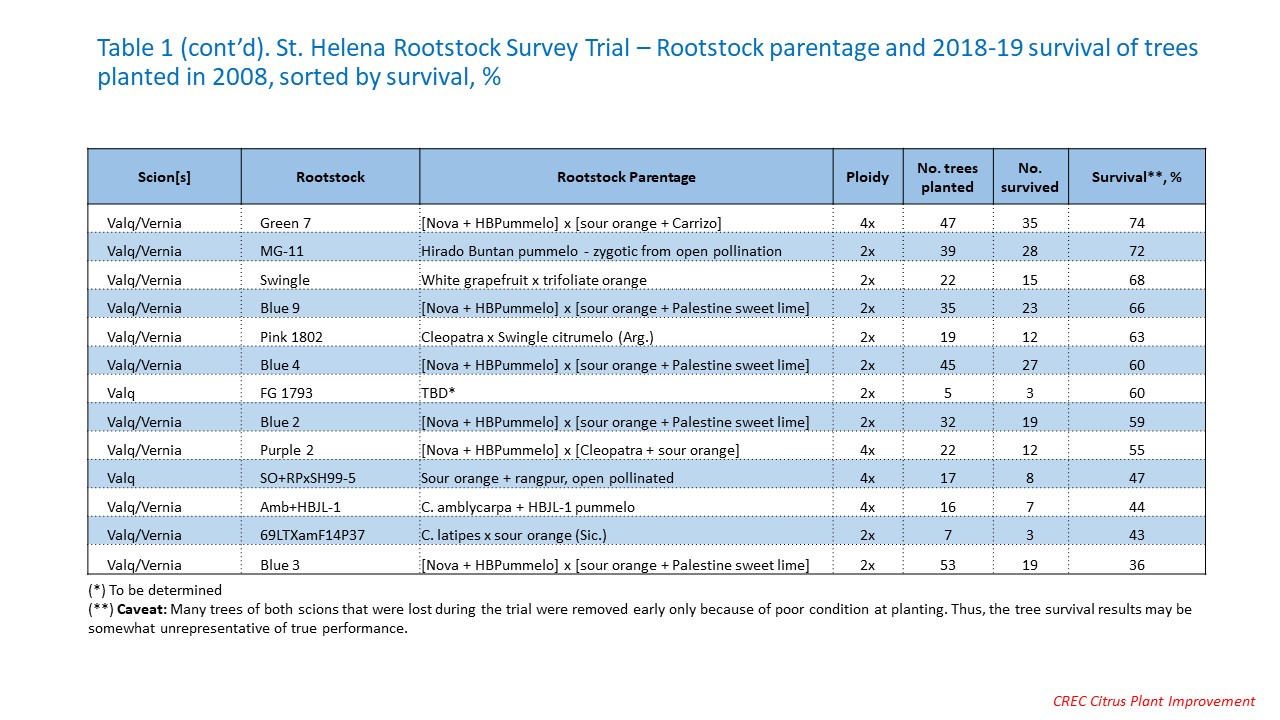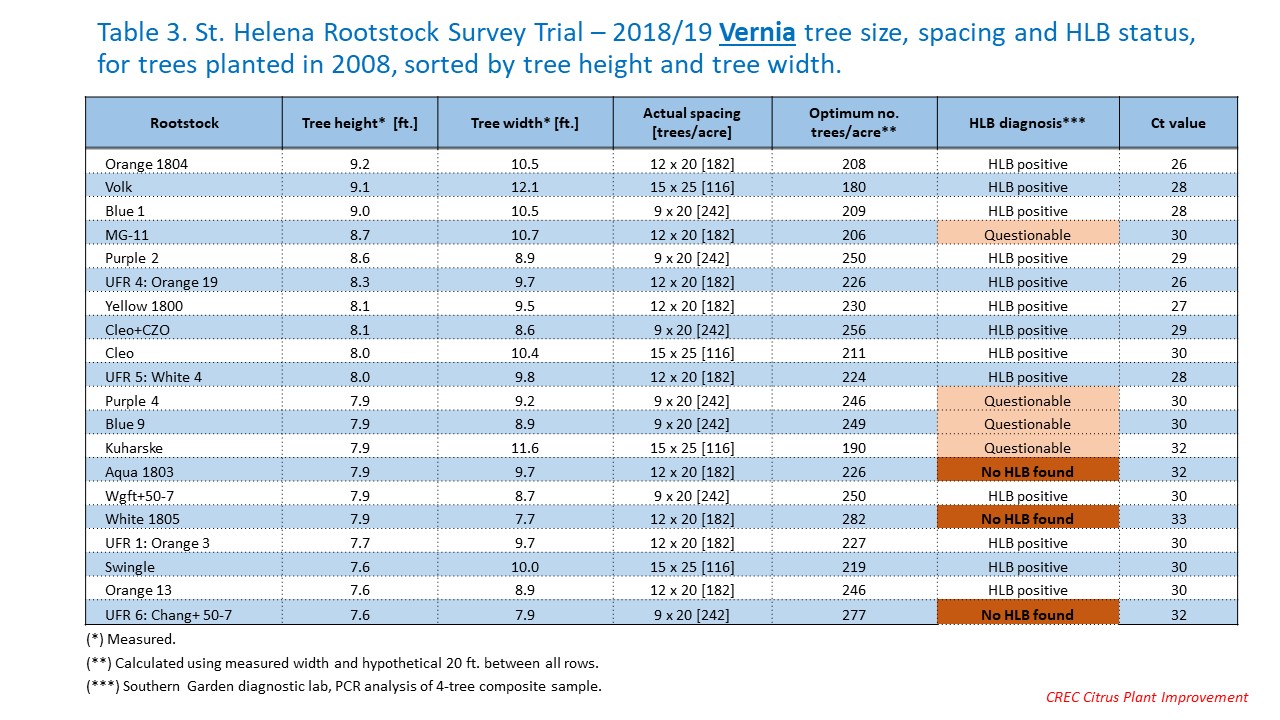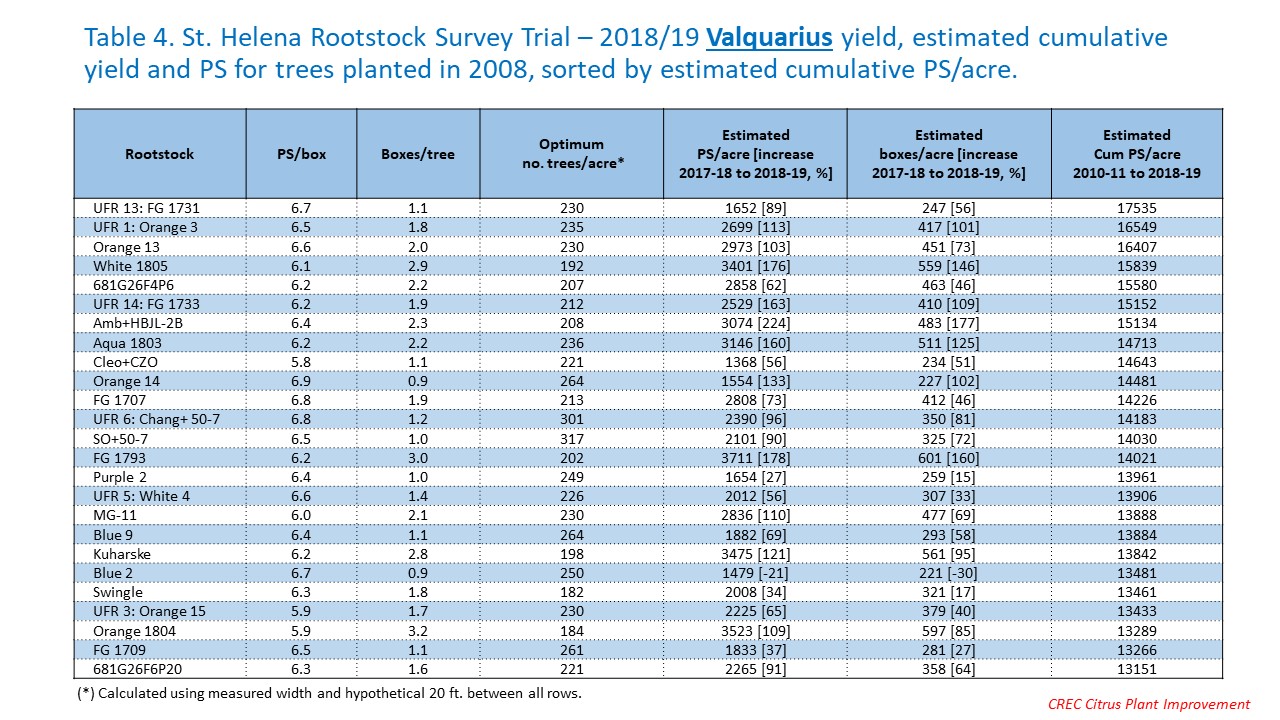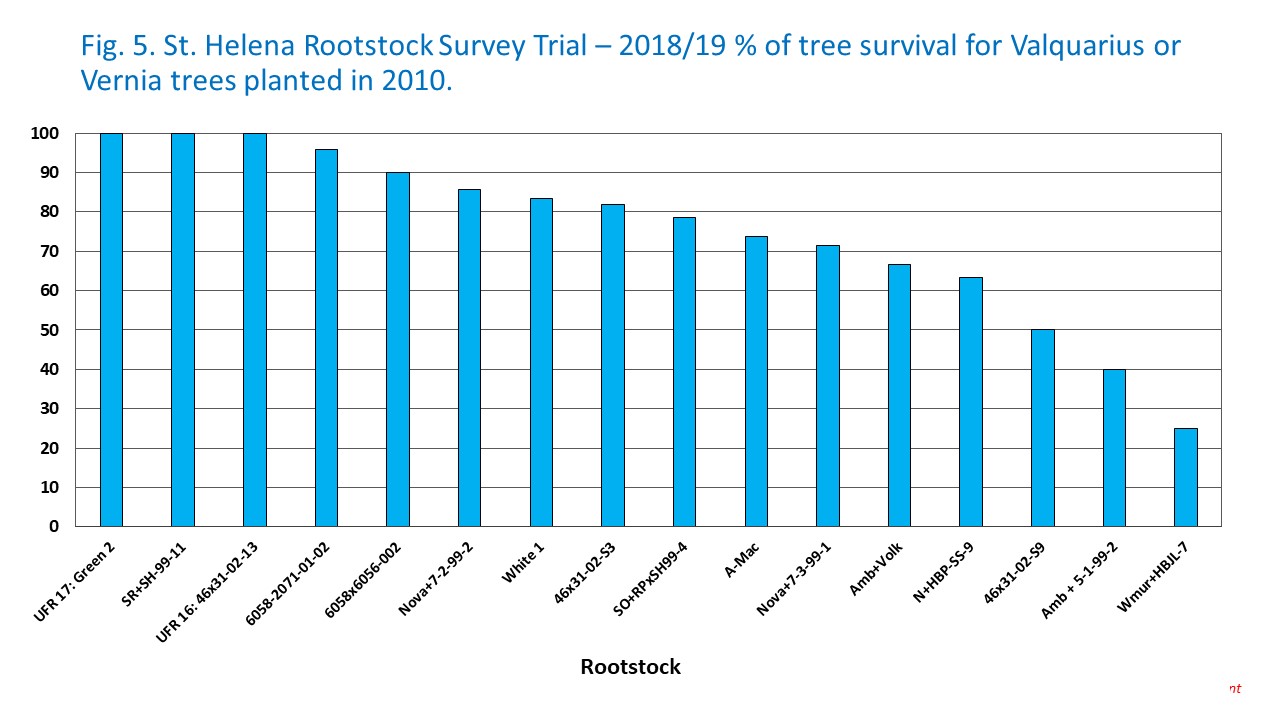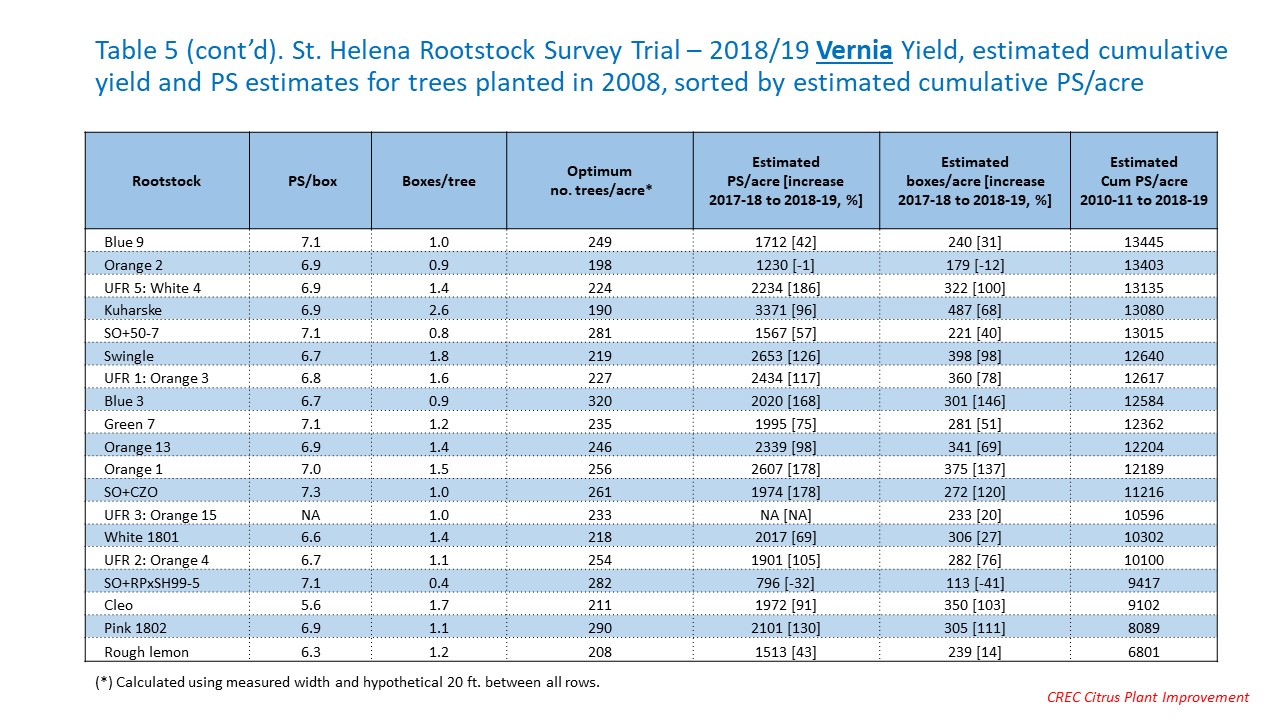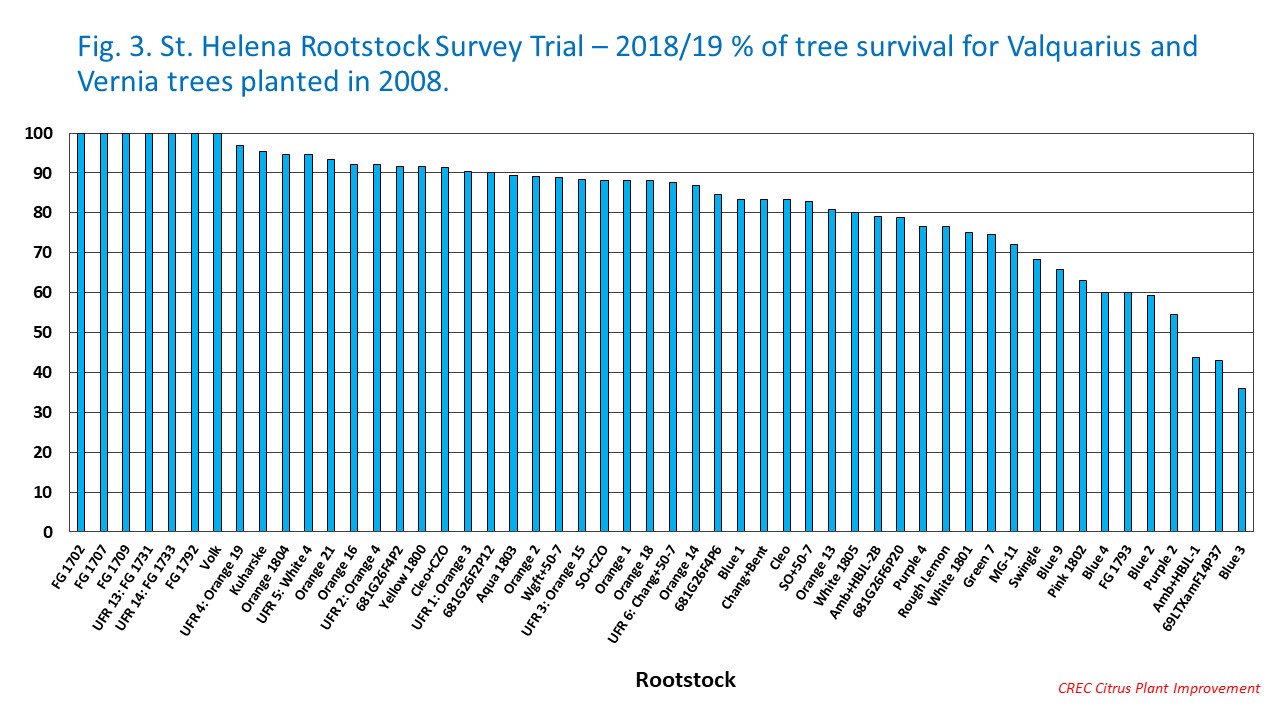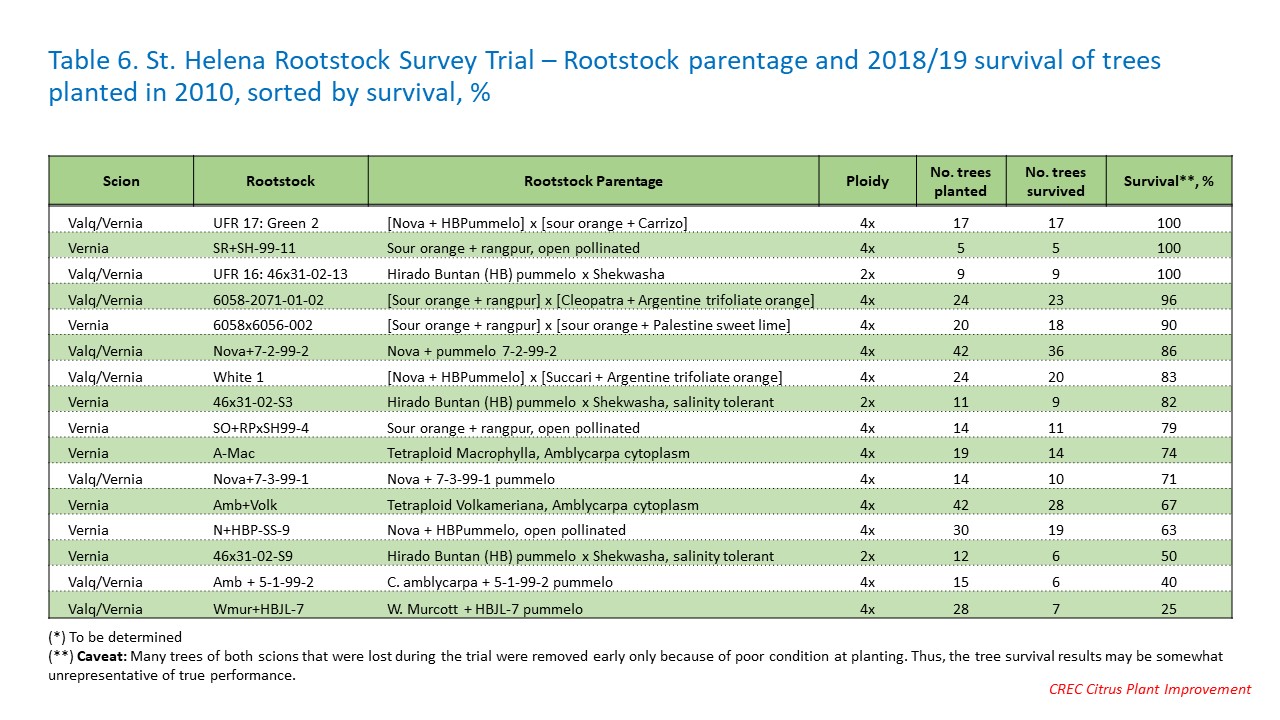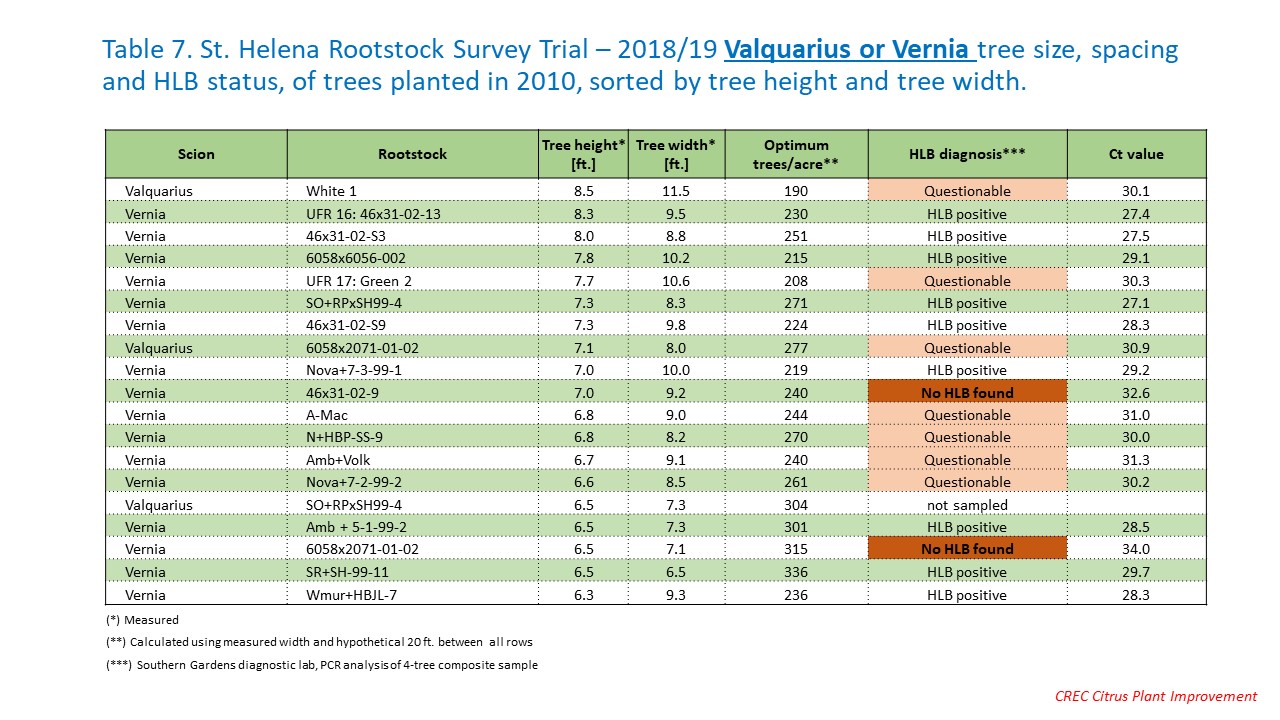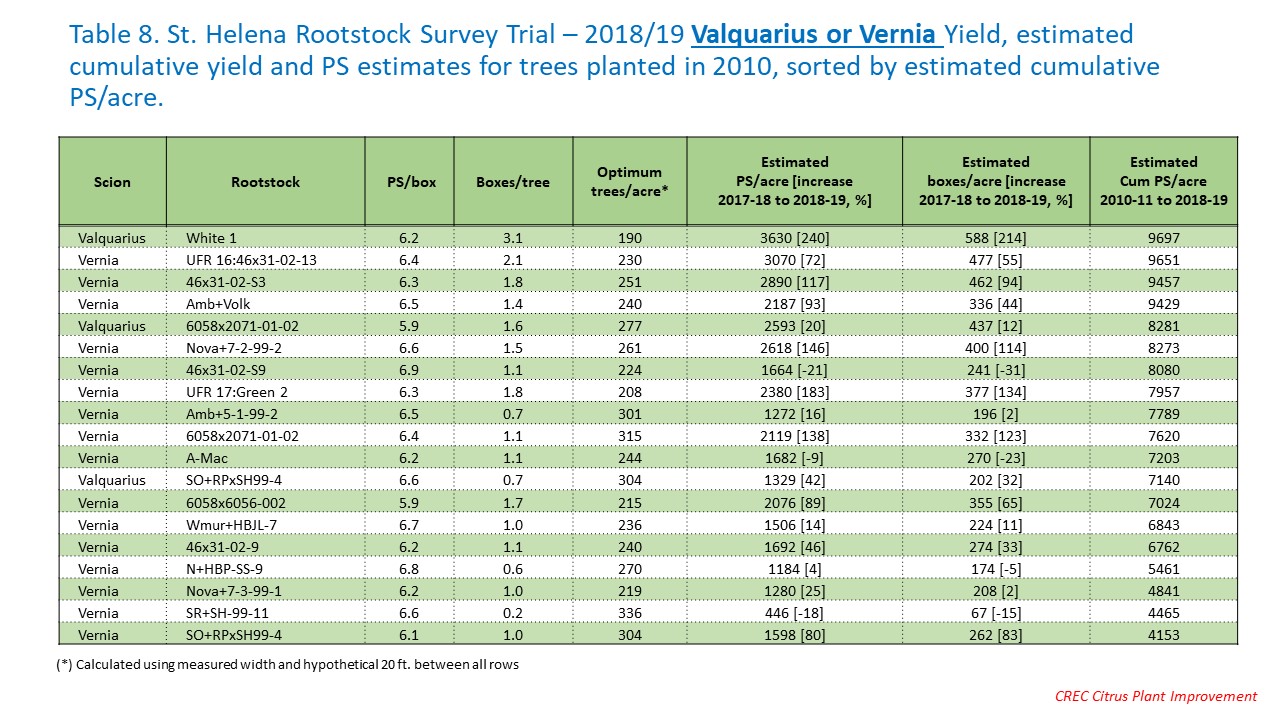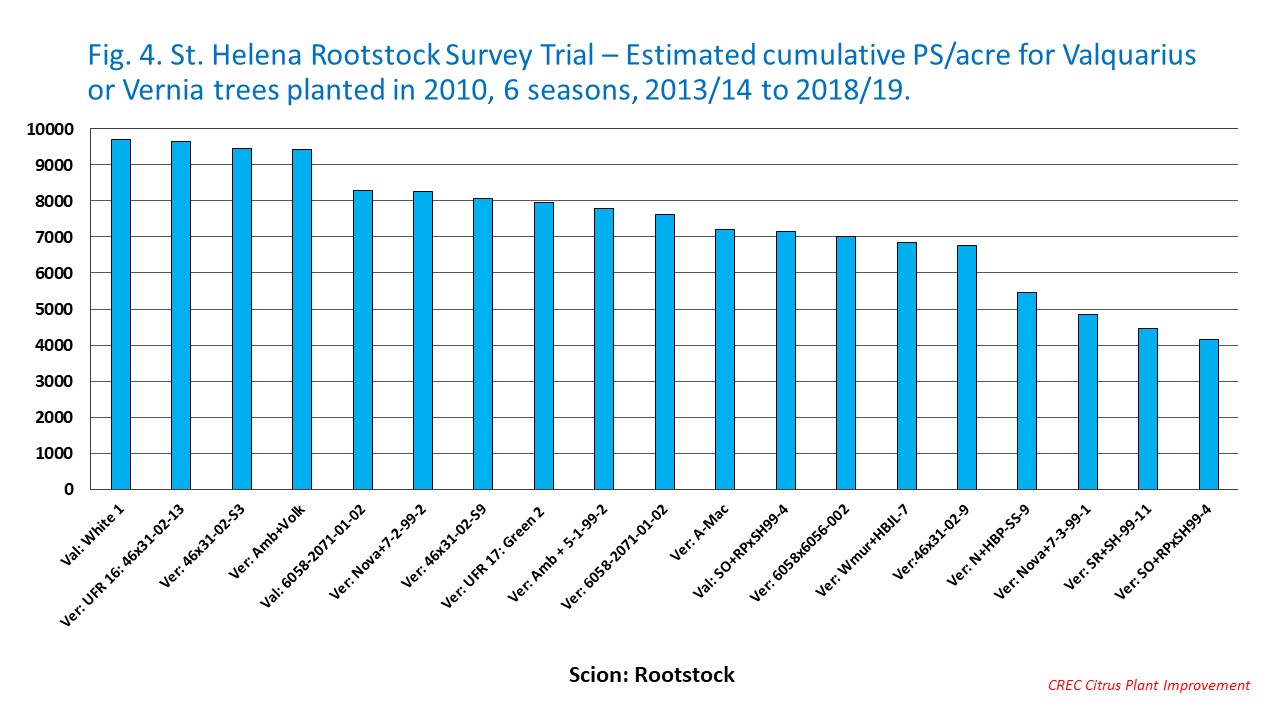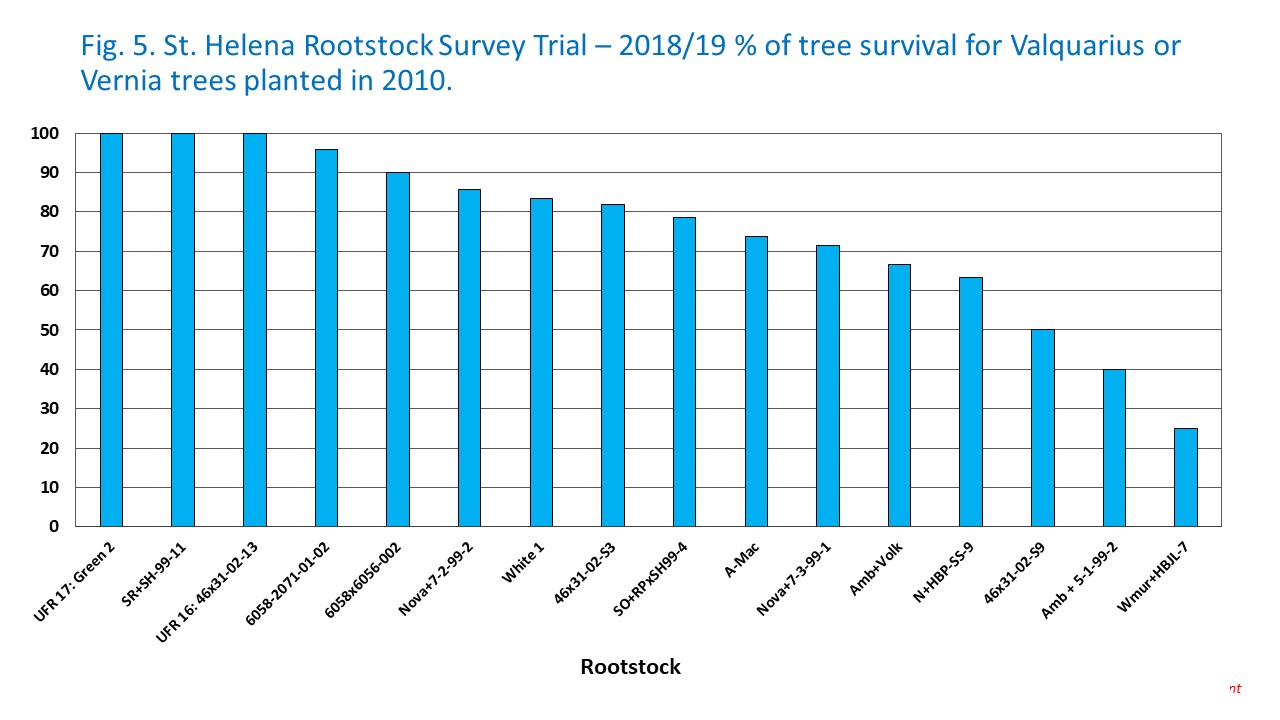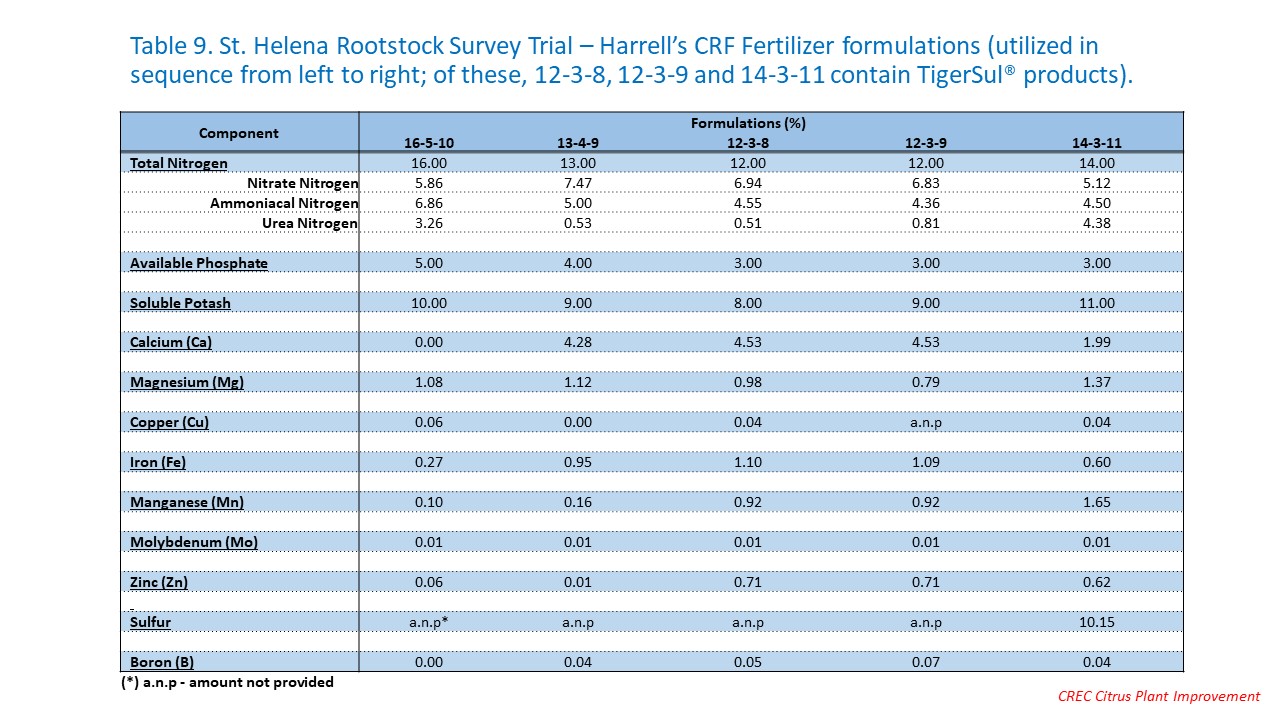St Helena Rootstock Survey Trial
Dr. Jude Grosser – Dr. Fred Gmitter – Dr. Bill Castle
Orie N. Lee and Lee Family Groves
October 8, 2019
CREC Citrus Plant Improvement
St Helena Rootstock Survey Trial - Description
HISTORY:
The St. Helena Project was spear-headed by the late Hall of Fame Citrus Grower/Researcher Orie N. Lee. Mr. Lee made significant financial and intellectual contributions to the project. He found and purchased the property (19.9 acres on St. Helena Rd., east of Dundee), had the old trees cleared, fixed the well twice, provided a back-up diesel generator, and had a protective structure built over the well pump. Since this time (2008), the Lee Family has been leasing the property to the Citrus Research and Education Foundation (CREF) for $1/year. Profits from harvested fruit have gone 100% back to the CREF to support research grove care.
The original idea for the project was to test new sweet orange selections that had potential to improve juice products. However, as HLB spread across the state, the objective changed to evaluating as many new rootstock candidates as possible to identify those that could impart HLB tolerance. The UF/CREC Citrus Improvement Team (Grosser, Gmitter and Castle) then gathered the available rootstocks (propagations from both seed and cuttings) including many diploid and tetraploid selections from the UF/CREC breeding program along with selections from the Sicilian (Reforgio-Recuperato) and Argentinian (Foguet) rootstock breeding programs. Vernia and Valquarius, mid-season processing oranges that generally can be harvested beginning mid-January with Valencia quality, were chosen as the scions for the project.
The original idea for the project was to test new sweet orange selections that had potential to improve juice products. However, as HLB spread across the state, the objective changed to evaluating as many new rootstock candidates as possible to identify those that could impart HLB tolerance. The UF/CREC Citrus Improvement Team (Grosser, Gmitter and Castle) then gathered the available rootstocks (propagations from both seed and cuttings) including many diploid and tetraploid selections from the UF/CREC breeding program along with selections from the Sicilian (Reforgio-Recuperato) and Argentinian (Foguet) rootstock breeding programs. Vernia and Valquarius, mid-season processing oranges that generally can be harvested beginning mid-January with Valencia quality, were chosen as the scions for the project.
PLANTING AND TREE CARE:
The first set of trees was planted in 2008 [about 12 acres] in 4-tree rectangular plots. Trees were planted in one of 3 sections with a different spacing in each section: [1] 9 x 20 [for dwarf-sized trees]; [2] 12 x 20; and [3] 15 x 25 ft. Rootstocks were chosen for a particular section based on a predicted/expected size. There were uneven numbers of 4-tree plots for each rootstock selection.
HLB was first observed in the trial 6 months after the initial planting. The trial has had strong HLB pressure during its entire life as there was an unsprayed block of K-earlies adjacent to the trial block on the east side and, later, a top-worked block on the south side that was a major psyllid attractant.
A second major set of trees was planted in 2010. There were two subsequent plantings, but they were devastated by freezes primarily because the irrigation well volume was not sufficient to provide cold-protection via microjets to the entire trial. As a result, CRDF funded the installation of a larger well that now provides cold protection for the entire trial.
Cultural care of the trial is provided by the CREC Grove Care Team managed by Troy Gainey.
NUTRITION:
The nutrition/irrigation program was designed to minimize any stress on the trees and, thereby, allow maximum expression of HLB tolerance. The trees at the beginning were fertilized with a Harrell’s nursery mix of controlled release fertilizer [CRF] applied about every 6 months.
Initially, trees were irrigated 3 times per week, but that schedule was later changed to a daily irrigation regime with shorter application intervals.
In cooperation with Harrell’s, who supplied their products at no cost, the CRF was modified to enhance the micronutrient content. The first change was to use a CRF mix that contained calcium nitrate and boron (not included in the nursery mix). Next, the revised mix contained elevated micronutrients, some provided in the TigerSul® form. In January 2018, the CRF mix was modified to increase the nutrients again, especially magnesium and manganese (see the 14-3-11 label). A noticeable improvement in tree appearance was observed. Over the 2017-18 and 2018-19 seasons, the trees received supplemental soluble dry fertilizer via broadcasting.
DATA COLLECTION: Yield has been measured annually in boxes/tree and fruit quality samples of about 50 fruit/plot have been collected since 2011. An effort was made to obtain data from a minimum of one 4-tree plot for each scion/rootstock combination each season and from two plots per combination when possible. Tree canopy size was also measured and used to predict the optimum tree spacing for each combination. Measured yield and fruit quality data were combined to estimate the pounds-solids that could be produced for each scion/rootstock combination if trees were planted at their optimum spacing.
COMMENTS: HLB quickly moved into this trial and initially appeared among the trees on the standard commercial rootstocks. The older, established trees have been 100% infected for several years.
The 2017-18 season was below average with low yields and reduced juice quality across the entire trial possibly because of Hurricane Irma and a significant delay in one of the CRF applications. However, in the 2018-19 season there was a 62% increase in yield and a 20% increase in juice quality across the entire trial.
Although many rootstocks showed a good recovery in the 2018-19 season, there are a few rootstocks that have performed well during the entire life of the trial.
St Helena Survey Rootstock Trial
Location – Dundee, Polk county
Scion – Vernia & Valquarius
Rootstocks - large collection of new diploid and tetraploid rootstocks
Date planted – 2008 & 2010
Design – According to the number of trees available
- Replications: variable per rootstock
- Plot size: 4-tree rectangular
- Spacing: 9 x 20; 12 x 20; 15 x 25 ft.
Data
- Yield and juice quality: 9 seasons, 2010-11 to 2018-19
- Tree size: 2019
- % of tree survival: 2018/19
- CRF Fertilizer formulation
- Trial status: ACTIVE.

.jpg)


